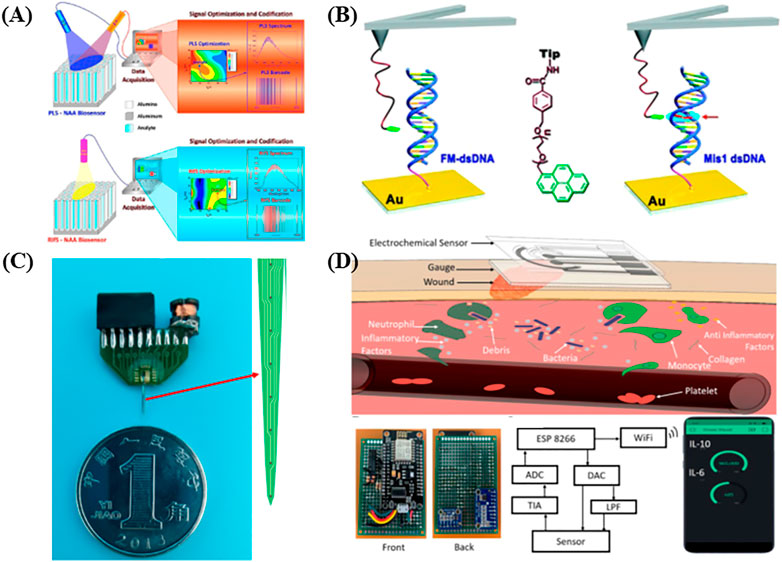
94% of researchers rate our articles as excellent or good
Learn more about the work of our research integrity team to safeguard the quality of each article we publish.
Find out more
EDITORIAL article
Front. Nanotechnol., 11 April 2022
Sec. Biomedical Nanotechnology
Volume 4 - 2022 | https://doi.org/10.3389/fnano.2022.897091
This article is part of the Research TopicAdvanced Nanomaterials and Nanostructure-Based Sensors for Biomedical ApplicationsView all 5 articles
Editorial on the Research Topic
Advanced Nanomaterials and Nanostructure-Based Sensors for Biomedical Applications
To enhance the performance of sensors for biomedical applications, various kinds of advanced micro-nanomaterials, and micro-nanostructures including nanoscale probes have been utilized as the basis for sensors for the past decades. These sensors have been widely used for disease biomarker detection including both protein and nucleic acid biomarkers, single molecule detection, volatile organic compounds (VOCs) sensing, neural sensing, pressure sensing such as intraocular pressure monitoring, and skin sensing. In this Special issue, we focus on chemical and biochemical sensing and analyses using various types of the sensors, which are enabled by arrayed nanopores, cantilever-type nanoprobes, microelectrode arrays, and carbon nanotubes decorated with gold nanoparticles, respectively.
The Research Topic of Frontiers in Nanotechnology entitled “Advanced nanomaterials and nanostructures-based sensors for biomedical applications” presents a total of four papers (Figure 1), including two reviews and two original research papers. The review by Feng and Ji summarizes the progress of one nanomaterial self-ordered nanoporous structure anodic aluminum oxide (AAO) and its applications (Feng and Ji). This review is primarily focused on four types of AAO-based optical biosensing technologies: surface-enhanced Raman scattering, surface plasmon resonance, reflectometric interference spectroscopy, and photoluminescence spectroscopy. The review by Anwesha Sarkar summarizes the principle and some main applications of atomic force microscopy (AFM), specifically showcasing the nanoscale probes and chemically modified nanoscale probes of AFM as biosensors, to characterize other sensors, to improve drug delivery approaches, and to discuss future possibilities (Sarkar). The original research paper by Yamin Li et al. reports a wireless closed-loop system for epilepsy detection and suppression (Li et al.). This system consists of an implantable optrode, wireless recording, wireless energy supply, and a control module. The optrode is a microstructure formed by integrating a silicon microelectrode array (MEA) with an LED probe. The functions of the system have been demonstrated through animal experiments, including local field potential (LFP) real-time monitoring, seizure detection, wireless energy supply, light to release RuBi-GABA, and inhibiting seizures, indicating its potential as a practical wireless epilepsy therapy system. The original research by Noushin et al. reports a wearable wound patch for multiplexed monitoring wound biomarkers at the wound site, thereby providing real-time feedback on the inflammation phase of the wound (Noushin et al.) The sensing patch was fabricated utilizing an optimal composition of gold nanoparticles integrated multiwalled carbon nanotubes. In addition, a miniaturized Internet-of-things (IoT)-enabled potentiostat was developed and integrated with the patch, forming a wearable system, resulting in a solution to wound care through continuous, real-time, and in-situ monitoring of multiple wound biomarkers.

FIGURE 1. (A) Schematic illustration of two representative sensors based on AAO nanopore thin film (Feng and Ji) (B) Schematic illustration of AFM nanoprobe-enabled biosensor for measuring most probable unbinding forces between matched and mismatched pairs of dsDNA (Sarkar) (C) Photo of an Optrode packaged on the PCB (Li et al.) (D) Schematic illustration of the flexible smart wound patch placed at the wound site. Photo of the front and back side of the developed IoT-enabled potentiostat. Block diagram of the IoT chronic wound analysis system (Noushin et al.).
We hope the papers in this topic would trigger some new ideas using micro-nanomaterials and micro-nanostructures for next generation biomedical sensing technical platforms. We also would like to thank all authors of the papers published in this topic. The careful and timely reviews by reviewers for ensuring the quality of this research topic are also greatly appreciated.
All authors listed have made a substantial, direct, and intellectual contribution to the work and approved it for publication.
The authors declare that the research was conducted in the absence of any commercial or financial relationships that could be construed as a potential conflict of interest.
All claims expressed in this article are solely those of the authors and do not necessarily represent those of their affiliated organizations, or those of the publisher, the editors and the reviewers. Any product that may be evaluated in this article, or claim that may be made by its manufacturer, is not guaranteed or endorsed by the publisher.
Keywords: nanomaterials, nanostructures, biosensors, biomarkers, biomedical applications
Citation: Que L, Wang D, Wei J and Chen PY (2022) Editorial: Advanced Nanomaterials and Nanostructure-Based Sensors for Biomedical Applications. Front. Nanotechnol. 4:897091. doi: 10.3389/fnano.2022.897091
Received: 15 March 2022; Accepted: 22 March 2022;
Published: 11 April 2022.
Edited and reviewed by:
Ajeet Kaushik, Florida Polytechnic University, United StatesCopyright © 2022 Que, Wang, Wei and Chen. This is an open-access article distributed under the terms of the Creative Commons Attribution License (CC BY). The use, distribution or reproduction in other forums is permitted, provided the original author(s) and the copyright owner(s) are credited and that the original publication in this journal is cited, in accordance with accepted academic practice. No use, distribution or reproduction is permitted which does not comply with these terms.
*Correspondence: Long Que, bHF1ZUBpYXN0YXRlLmVkdQ==
Disclaimer: All claims expressed in this article are solely those of the authors and do not necessarily represent those of their affiliated organizations, or those of the publisher, the editors and the reviewers. Any product that may be evaluated in this article or claim that may be made by its manufacturer is not guaranteed or endorsed by the publisher.
Research integrity at Frontiers

Learn more about the work of our research integrity team to safeguard the quality of each article we publish.